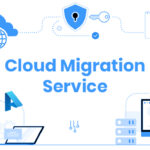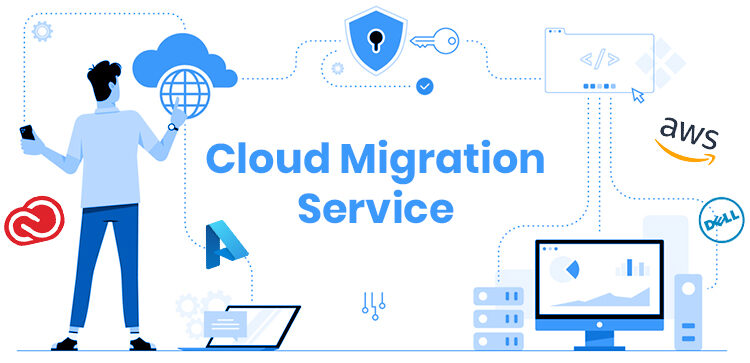Migration strategies are purposely used to increase operational scalability, flexibility, performance and cost savings in the previous set of IT infrastructure. A cloud migration strategy offers numerous benefits to organizations such as making operations cost-effective and sustainable.
What is Cloud Migration?
Cloud migration refers to the activity of moving digital assets such as applications, data workloads or IT resources to cloud infrastructure, or from one cloud to another. This movement of IT resources may either be partially or wholly.
Depending on different business requirements, the process of planning and execution requires proper analysis and careful consideration to ensure the compatibility of cloud solutions. While migrating to the cloud, it is important to choose options carefully to rebuild applications to experience optimal performance in the cloud.
Purpose of Cloud Migration
Companies move to the cloud in order to overcome a limitation in certain aspects of IT infrastructure and to provide better services and new solutions to customers. Cloud migration is an ideal strategy to pursue digital transformation initiatives without carrying the load of maintaining and owing to the underlying hardware. More specifically, cloud migration is a strategic plan to address the following risks:
- Aging IT infrastructure sometimes fails to deliver the necessary features required to serve employees and customers appropriately. This might be due to the lack of digital transformation in the previous setups.
- Hardware or software built on older technologies is easier to attack as it may lack the upgrades and latest security features.
- Due to costly management, legacy systems require expensive ongoing maintenance.
What Are The Major Benefits of Cloud Migration?
When it comes to cloud migration services benefits, it is difficult to figure out all the points together but without any doubt, this strategy offers numerous benefits to businesses or organizations. It provides the flexibility of connecting to your business virtually anywhere, any time. It allows to access applications from anywhere in the world at any time. Let’s consider some major benefits of cloud migration.
-
Cost Reduction
Moving applications to the cloud is a cost-efficient solution as businesses only need to pay for the space to the hosting company. Now, that simply means that the hardware, data centres, on-site servers’ expenses are all now the liabilities of the hosting company and you are now free to invest in business growth strategies.
-
Scalability
Cloud solutions are completely scalable as while using cloud migration services, you tend to pay for what you need. Businesses often witness fluctuations where sudden breakthroughs or enormous growth periods are usual effects and with moving applications to the cloud can allow businesses to scale with agility, without making unnecessary investments.
-
Security
Security can be considered as one of the most important benefits of cloud migration as data backed in the cloud is encrypted and is the safest mode to operate any business.
-
Speedy Disaster Recovery
Cloud protects businesses in case of any disaster. It allows users to run applications from anywhere in case of an emergency.
-
Enables Remote Working
Cloud-based businesses don’t require the presence of people to operate applications and instead, they can login and work from anywhere they want. During the lockdown period, cloud-based organizations were the best modes to operate while following the guidelines of work from home.
-
Collaborative Approach
Cloud-based software allows multiple people to work together as a team and it encourages a collaborative approach. Cloud hosting is an easy and smooth mode to do changes as multiple users can edit documents, synchronize items and then, finally save all the changes at a single point of time.
-
Time-Saving
Cloud migration is a brilliant strategy when it comes to saving your time. There is no need to update applications and software regularly and take back up while a business moves to the cloud. Cloud-based serves are the easiest and fastest means to communicate and work together which simply consumes less time, less efficiency and hence, a more productive way to organize business applications.
-
Future-Proofed
Cloud migration is a great strategy to strengthen business and make it future-ready. It makes business applications compatible to get connected easily to the rapidly changing technologies like Internet of Things-enabled devices, 5G networks, AI and Machine Learning etc. Moving to the cloud is the smartest way to adopt future changes which are going to be the core part of every business in the very near future.
All these benefits clarify that cloud migration is an important strategy for every tech-driven business to grow beyond the limitations without carrying over the liabilities of hosting on-site data centres and other IT resources.
Understanding Cloud Migration Process and How Does it Work?
Before migrating to cloud services, it is important for organizations to understand the process and what is involved in it. Moving to the cloud is a challenging move and to make this shift transformative to gather enough information on the major steps of cloud migration.
- Cloud migration is not just a technological shift rather it more specifically defines the objectives of the company. A cloud migration strategy can be prepared only on the basis of organizational goals and objectives. Choosing the applications wisely to be shifted to the cloud with the appropriate selection of cloud environment are the biggest challenges to avail the best benefits of this strategy.
- Assessments like what, where and when to move should be discovered by analyzing the risks elements involved in the process. As infrastructural changes in IT resources are critical decisions to be made, it is important to keep every aspect in mind including flexibility, cost and control.
- To execute a smooth migration strategy, elements like migration tools and automated management should be considered to deliver high speed, consistency and repeatability. To keep the business on the right path of growth, organizations should prefer a robust cloud journey management plan.
Also Read: How to Pick the Best Software Development Process?
What Are The Different Types of Cloud Migration?
Organizations approach to adopt different types of cloud migration strategies depending on what type will be fitted best for their business growth. There are 3 types of cloud migration strategies which businesses use to meet goals like better alignment between IT and business objectives.
-
Homogeneous “Lift-and-Shift” Migration
This migration strategy is used to lift an application out of its current hosting environment. Basically, like shifting the current hosting plan to a public cloud. This type of cloud hosting is great for increasing agility, it is like a new host to manage applications without making extensive charges.
-
Technical Migration
This type of cloud migration is used by businesses to meet certain transformational goals. In addition, this strategy is not only a way to manage applications but it is a great method to upgrade database and OS.
-
Application Migration
The application migration strategy is the complete transformation of the application layer along with the OS and DB. It can be further divided into three basic categories:
- New System Implementation: A complicated but cost-effective choice. Applications in this strategy are either rebuilt or replaced with new applications.
- System Conversion: This strategy involves extensive changes as it transforms your application layer.
- Landscape Transformation: This strategy is the method to provide a significant change to the structure of your landscape through a system conversion technique.
It is challenging to select the best migration strategy. It becomes more difficult for businesses to implement the right migration strategy in the correct order and hence, experts are available in the form of digital platform providers who have better ideas to deal with such conditions. Make a correct choice by selecting the right service provider to eliminate the risks of cloud migration and get a cost-effective and accelerated path of growth and success.




